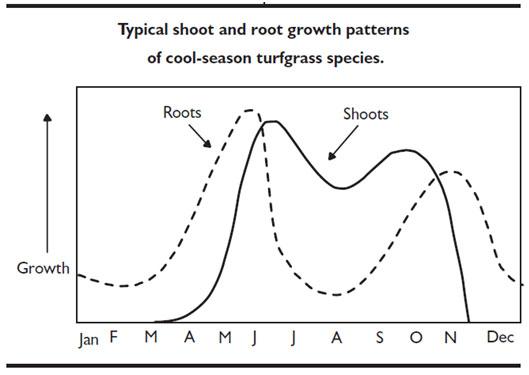In organic turf care, the best way to beat weeds is with grass seed. Soil temperature, germination time frames, and pH all affect growing healthy grass. Therefore, in the Northeast, the window to overseed in Spring caps by the end of May. Keep reading to learn more about choosing the right spring grass seed.
Whether dealing with residential or athletic fields, the goal is to get coverage as quickly as possible in the spring: quick coverage helps suppress weeds. Notably, in the spring, the overseeding window to establish grass can be very short. As such, choosing the right grass seed blend is important.
Pros and Cons of Grass Seed Cultivars:

Cool-season grasses do best in the Northeast. Shoots begin developing in the temperature range of 60° to 75°F. Roots develop at temperatures of 50° to 65°F. There is no one best cool-season grass variety. A blend of turf grass varieties will do best based on site conditions.
TriRye Perennial Ryegrass
Known for quick germination (5-7 days), good wear tolerance, average nutritional needs, fair heat tolerance but poor shade and drought tolerance. Goes dormant in summer heat and drought.
Turf Type Tall Fescue
Average germination (10-14 days) in warmer soil conditions, very good drought tolerance, good wear, shade, and heat tolerance. Turf type tall requires less nutritional needs but does not compete well in established turf so use a blend with high % TTTF and lower perennial rye or Kentucky blue. Can go dormant in the summer but its outstanding heat tolerance keeps a tall canopy in irrigated lawns keeps performance going all summer – the prime time to compete against undesired weed species.
Fine Fescue
Average germination (10-14 days), excellent in shade, low nutritional needs, very good in drought, fair heat tolerance but low wear tolerance. Not for sunny areas.
Kentucky Bluegrass
Slow germination (21-28 days), good wear tolerance, highest nutritional needs, fair in heat, poor shade and drought tolerance. Can be difficult to establish in spring. Kentucky blue performs best in early summer and fall – it will avoid dormancy is well irrigated lawns over the summer.
PJC’s Top Spring Seed Performers
Athletic Fields: 100% Tri Rye in April-May 15th followed by 80% Perennial Ryegrass, 20% Kentucky Bluegrass in May or 70/20/10 by June 15th.
Residential Lawns: 100% Tri Rye for sun and 85% Fine Fescue, 10% Perennial Ryegrass, 5% Kentucky Bluegrass for shade. If unable to water skip spring seeding and focus n fall
How to Overseed
Importantly, once you’ve chosen your seed, how you get the seed to soil contact is as important. For small, thin, damaged areas: rough up the surface with an iron rake. Then, mix the seed with a loam/compost mix, broadcast over affected area, and raking it out is sufficient. Conversely, on larger areas, we recommend slice seeding to get good soil to seed contact and avoid core aeration that can bring weed seeds to the surface early in the season.
Lastly, want more info on choosing the right spring grass seed, or interested in product pricing? Contact us!
